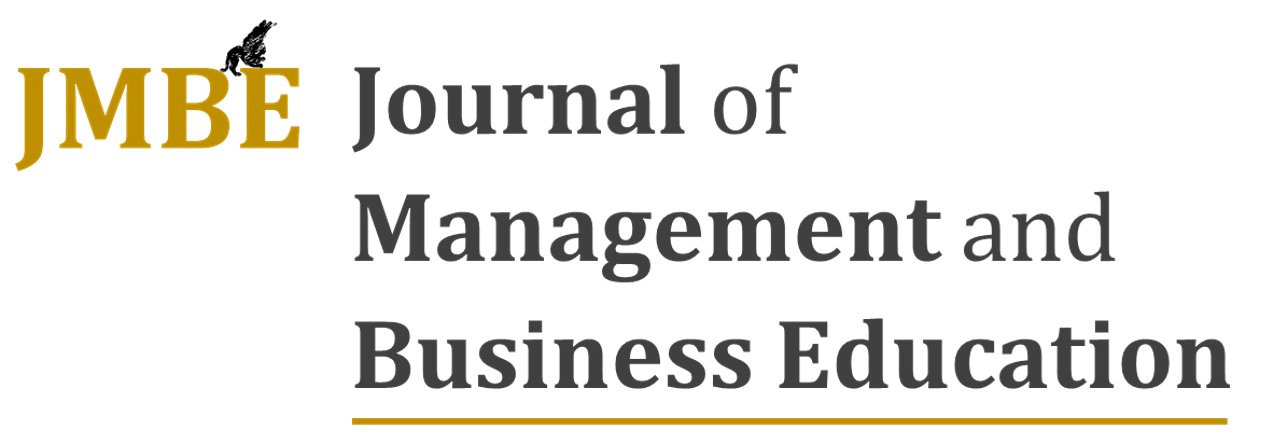Virtual classroom: teacher skills to promote student engagement
DOI:
https://doi.org/10.35564/jmbe.2018.0008Keywords:
Virtual Classroom, Virtual Learning Environments, Student Engagement, Teacher Behavior, Teacher-Student RelationshipAbstract
The Virtual Classroom is the main tool for blended learning, since it allows the breaking of time and space barriers between the teacher and the student. In order to develop and put into practice a higher studies course through this tool, teachers need to have a series of skills related to the command of digital technologies and an understanding of students’ affective and behavioral states: and to then apply appropriate communication strategies to deliver course content and prepare students for this innovative learning approach. This study reviews educational research literature on virtual classrooms, teacher behavior and student engagement to establish a theoretical model that explains the type of abilities that teachers must develop to achieve student engagement in academic activities. These abilities are classified in three categories: technical, affective and communicative. Furthermore, several learning theories (objectivism, constructivism and connectivism) are reviewed to conduct an appropriate Virtual Classroom design and implementation that can adapt to each student’s specific learning needs. Future study lines, as well as empirical proposals to go deeper into these theoretical propositions, are presented.
Downloads
References
Alt, D. (2015). Assessing the contribution of a constructivist learning environment to academic self-efficacy in higher education. Learning Environments Research, 18(1), 47-67.
https://doi.org/10.1007/s10984-015-9174-5
Anderson, H. J., Baur, J. E., Griffith, J. A., & Buckley, M. R. (2017). What works for you may not work for (Gen) Me: Limitations of present leadership theories for the new generation. The Leadership Quarterly, 28(1), 245-260.
https://doi.org/10.1016/j.leaqua.2016.08.001
Appleton, J. J., Christenson, S. L., Kim, D., & Reschly, A. L. (2006). Measuring cognitive and psychological engagement: Validation of the Student Engagement Instrument. Journal of School Psychology, 44(5), 427-445.
https://doi.org/10.1016/j.jsp.2006.04.002
Arbaugh, J. B. (2018). One Bridge,(at Least) Two Paths: Reflections on "Virtual Classroom Characteristics and Student Satisfaction in Internet-Based MBA Courses". Journal of Management Education, 42(4), 524-532.
https://doi.org/10.1177/1052562918770214
Becton, J. B., Walker, H. J., & Jones‐Farmer, A. (2014). Generational differences in workplace behavior. Journal of Applied Social Psychology, 44(3), 175-189.
https://doi.org/10.1111/jasp.12208
Callahan, R. E. (1962). Education and the cult of efficiency. Chicago: University of Chicago Press.
Chen, B., Chang, Y. H., Ouyang, F., & Zhou, W. (2018). Fostering student engagement in online discussion through social learning analytics. The Internet and Higher Education, 37(2), 21-30.
https://doi.org/10.1016/j.iheduc.2017.12.002
Collins, A., Brown, J. S., & Holum, A. (1991). Cognitive apprenticeship: Making thinking visible. American educator, 15(3), 6-11.
Cziko, G. A. (1989). Unpredictability and indeterminism in human behavior: Arguments and implications for educational research. Educational Researcher, 18(3), 17-25.
https://doi.org/10.2307/1174887
Dabbagh, N., & Kitsantas, A. (2012). Personal Learning Environments, social media, and self-regulated learning: A natural formula for connecting formal and informal learning. The Internet and higher education, 15(1), 3-8.
https://doi.org/10.1016/j.iheduc.2011.06.002
Darling-Hammond, L. (2006). Constructing 21st-century teacher education. Journal of Teacher Education, 57(3), 300-314.
https://doi.org/10.1177/0022487105285962
De Freitas, S. I., Morgan, J., & Gibson, D. (2015). Will MOOCs transform learning and teaching in higher education? Engagement and course retention in online learning provision. British Journal of Educational Technology, 46(3), 455-471.
https://doi.org/10.1111/bjet.12268
Downes, S. (2007). An Introduction to Connective Knowledge. In Hug, T. (Ed.), Media, Knowledge & Education - Exploring new Spaces, Relations and Dynamics in Digital Media Ecologies (pp.77-102). Insbruck: Insbruck University Press.
Elander, K. R. (2012). Merging paradigms: The integration of objectivist and constructivist approaches in university settings. Minneapolis: Capella University.
Fernandez-Cruz, F. J., & Fernandez-Diaz, M. J. (2016). Teachers Generation Z and their Digital Skills. Comunicar, 46, 97-105.
https://doi.org/10.3916/C46-2016-10
Fredricks, J. A., Blumenfeld, P. C., & Paris, A. (2004). School engagement: Potential of the concept: State of the evidence. Review of Educational Research, 74, 59-119.
https://doi.org/10.3102/00346543074001059
Fuad, M., Deb, D., Etim, J., & Gloster, C. (2018). Mobile response system: a novel approach to interactive and hands-on activity in the classroom. Educational Technology Research and Development, 66(2), 493-514.
https://doi.org/10.1007/s11423-018-9570-5
Giambatista, R. C., Hoover, J. D., & Tribble, L. (2017). Millennials, learning, and development: Managing complexity avoidance and narcissism. The Psychologist-Manager Journal, 20(3), 176-193.
https://doi.org/10.1037/mgr0000056
Gobert, J. D., Baker, R. S., & Wixon, M. B. (2015). Operationalizing and detecting disengagement within online science microworlds. Educational Psychologist, 50(1), 43-57.
https://doi.org/10.1080/00461520.2014.999919
Greenhow, C., Robelia, B., & Hughes, J. E. (2009). Learning, teaching, and scholarship in a digital age: Web 2.0 and classroom research: What path should we take now? Educational researcher, 38(4), 246-259.
https://doi.org/10.3102/0013189X09336671
Hauptfeld, P. & C. Kummer, C. (2017). Applying service design to set the stage for the next teaching generation 2030. INTED2017 Proceedings, 3190-3198.
https://doi.org/10.21125/inted.2017.0822
Heggart, K. R., & Yoo, J. (2018). Getting the Most from Google Classroom: A Pedagogical Framework for Tertiary Educators. Australian Journal of Teacher Education, 43(3), 140-153.
https://doi.org/10.14221/ajte.2018v43n3.9
Henrie, C. R., Halverson, L. R., & Graham, C. R. (2015). Measuring student engagement in technology-mediated learning: A review. Computers & Education, 90, 36-53.
https://doi.org/10.1016/j.compedu.2015.09.005
Hoover, J. D. (2014). Complexity avoidance, narcissism and experiential learning. Developments in Business Simulation and Experiential Learning, 38, 255-260.
Hung, N. M. (2014). Using ideas from connectivism for designing new learning models in Vietnam. International Journal of Information and Education Technology, 4(1), 76-82.
https://doi.org/10.7763/IJIET.2014.V4.373
Novo-Corti, I., L. Varela-Candamio, L. & M. Ramil-Díaz, M. (2013). E-learning and face to face mixed methodology: Evaluating effectiveness of e-learning and perceived satisfaction for a microeconomic course using the Moodle platform. Computers in Human Behavior, 29(2), 410-415.
https://doi.org/10.1016/j.chb.2012.06.006
Imenda, S. (2017). In Search of a Psychology of Teaching and Learning for the 21st Century. Journal of Psychology, 8(2), 83-94.
https://doi.org/10.1080/09764224.2017.1409330
Kahu, E. R. (2013). Framing student engagement in higher education. Studies in Higher Education, 38(5), 758-773.
https://doi.org/10.1080/03075079.2011.598505
Kaiser, J., Retelsdorf, J., Südkamp, A., & Möller, J. (2013). Achievement and engagement: How student characteristics influence teacher judgments. Learning and Instruction, 28, 73-84.
https://doi.org/10.1016/j.learninstruc.2013.06.001
Kaplan, A. M., & Haenlein, M. (2016). Higher education and the digital revolution: About MOOCs, SPOCs, social media, and the Cookie Monster. Business Horizons, 59(4), 441-450.
https://doi.org/10.1016/j.bushor.2016.03.008
Klem, A. M., & Connell, J. P. (2004). Relationships matter: Linking teacher support to student engagement and achievement. Journal of School Health, 74(7), 262-273.
https://doi.org/10.1111/j.1746-1561.2004.tb08283.x
Kop, R. (2011). The challenges to connectivist learning on open online networks: Learning experiences during a massive open online course. The International Review of Research in Open and Distributed Learning, 12(3), 19-38.
https://doi.org/10.19173/irrodl.v12i3.882
Kop, R., & Hill, A. (2008). Connectivism: Learning theory of the future or vestige of the past? The International Review of Research in Open and Distributed Learning, 9(3), 1-13.
https://doi.org/10.19173/irrodl.v9i3.523
Lakoff, G. (1987) Women, fire, and dangerous things. Chicago: University of Chicago Press.
https://doi.org/10.7208/chicago/9780226471013.001.0001
Li, K. M. (2015). Learning styles and perceptions of student teachers of computer-supported collaborative learning strategy using wikis. Australasian Journal of Educational Technology, 31(1), 32-50.
https://doi.org/10.14742/ajet.521
Liew, T. W., Zin, N. A. M., & Sahari, N. (2017). Exploring the affective, motivational and cognitive effects of pedagogical agent enthusiasm in a multimedia learning environment. Human-centric Computing and Information Sciences, 7(1), 9-30.
https://doi.org/10.1186/s13673-017-0089-2
Merchant, G. (2007). Writing the future in the digital age. Literacy, 41(3), 118-128.
https://doi.org/10.1111/j.1467-9345.2007.00469.x
Ng, W. (2012). Can we teach digital natives digital literacy? Computers & Education, 59(3), 1065-1078.
https://doi.org/10.1016/j.compedu.2012.04.016
Perkins, D. (1998). "What is understanding". In M. S. Wiske (Ed.), Teaching for understanding (pp. 39-57). San Francisco, CA: Jossey-Bass Publishers.
Piaget, J. & Duckworth, E. Genetic epistemology. American Behavioral Scientist, 13(3), 459-480.
https://doi.org/10.1177/000276427001300320
Piccoli, G., Ahmad, R., & Ives, B. (2001). Web-based virtual learning environments: A research framework and a preliminary assessment of effectiveness in basic IT skills training. MIS Quarterly, 25(4), 401-426.
https://doi.org/10.2307/3250989
Quin, D. (2017). Longitudinal and contextual associations between teacher-student relationships and student engagement: A systematic review. Review of Educational Research, 87(2), 345-387.
https://doi.org/10.3102/0034654316669434
Redondo-Duarte, S., Sánchez-Mena, A., Navarro-Asencio, E., & Vega, S. G. (2017). Design of a pedagogical model to promote knowledge generation in virtual communities. International Journal of Learning Technology, 12(1), 3-25.
https://doi.org/10.1504/IJLT.2017.083998
Rotherham, A. J., & Willingham, D. T. (2010). 21st-Century skills. American Educator, 17, 17-20.
Seaman, J. E., Allen, I. E., & Seaman, J. (2018). Grade Increase: Tracking Distance Education in the United States. Babson Survey Research Group. Available at https://files.eric.ed.gov/fulltext/ED580852.pdf. Accessed on July 6, 2018.
Siemens, G. (2005). Connectivism: A learning theory for the digital age. International Journal of Instructional Technology and Distance Learning, 2(1), 3-10.
Sinha, S., Rogat, T. K., Adams-Wiggins, K. R., & Hmelo-Silver, C. E. (2015). Collaborative group engagement in a computer-supported inquiry learning environment. International Journal of Computer-Supported Collaborative Learning, 10(3), 273-307.
https://doi.org/10.1007/s11412-015-9218-y
Skinner, E. A., & Pitzer, J. R. (2012). Developmental dynamics of student engagement, coping, and everyday resilience. In Christenson, S.L. (Ed.) Handbook of research on student engagement (pp. 21-44). Springer: Boston, MA.
https://doi.org/10.1007/978-1-4614-2018-7_2
Tribble, L., Hoover, J. D., & Giambatista, R. C. (2016). Experiential Learning Potential as a Function of Psychological Predispositions and Demographic Variables. Developments in Business Simulation and Experiential Learning, 43(1).
Tyler, R. W. (1949). Basic principles of curriculum and instruction. Chicago: The University of Chicago Press.
Vygotsky,L. (1978). Interaction between learning and development. In Cole, M., John-Steiner, V., Scribner, S. & Souberman, E. (Eds.), Mind in society: The development of higher psychological processes, 79-91. Cambridge, Mass.: Harvard University Press.
Vrasidas, C. (2000). Constructivism versus objectivism: Implications for interaction, course design, and evaluation in distance education. International Journal of Educational Telecommunications, 6(4), 339-362.
Xerri, M. J., Radford, K., & Shacklock, K. (2018). Student engagement in academic activities: a social support perspective. Higher Education, 75(4),589-605.
https://doi.org/10.1007/s10734-017-0162-9
Yang, Y.-F. (2011). Engaging students in an online situated language learning environment. Computer Assisted Language Learning, 24(2), 181-198.
https://doi.org/10.1080/09588221.2010.538700
Zanjani, N., Edwards, S. L., Nykvist, S., & Geva, S. (2016). LMS acceptance: The instructor role. The Asia-Pacific Education Researcher, 25(4), 519-526.
Downloads
Published
How to Cite
Issue
Section
License
Copyright (c) 2023 Journal of Management and Business Education

This work is licensed under a Creative Commons Attribution-NonCommercial-ShareAlike 4.0 International License.
License terms at: https://creativecommons.org/licenses/by-nc/4.0/legalcode




